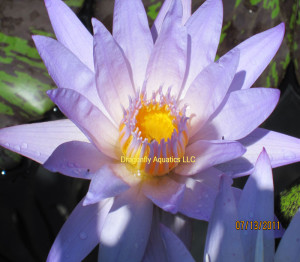 This has been a hot summer so far. Its important if you have fish in your pond that you make sure the water isn't too warm for them. As your water evaporates replenish with cool water. Your fish will be happy!
This has been a hot summer so far. Its important if you have fish in your pond that you make sure the water isn't too warm for them. As your water evaporates replenish with cool water. Your fish will be happy!
The tropical waterlilies sure are blooming up a storm in my pond.
The Albert Greenberg's colors are outstanding this year as are the other waterlilies. I'm not certain if its the hot summer days or just that all the pond plants are happy this year. These were all new plants this year since we just redid our pond so other than the initial fertilizing when I planted them, the first part of June, they haven't been fertilized since. I best get to that so I get as many flowers as possible before summer is over. I know tropical waterlilies last only during the summer but I seem to enjoy them more than the hardy waterlilies because of their colors.
Official its Fall now.....the other day it was 88 degrees out....today its 52 degrees and looks like fall. Chill in the air, cloudy skies and rain off and on. I still need a few more nice warm days before settling in for the dreaded winter months. I still have to prepare my pond for winter....I always seem to let it go until the last minute. Hopefully I get those few more warm days or I'll be sorry.
I decided to share some preparation tasks for your pond before the weather changes and we all settle in for the winter. This will help improve your pond water and hopefully help make the spring clean up less work.
FALL/WINTER POND MAINTENANCE TIPS
1. Before winter arrives, you will want to make sure your pond and filtering system are clean to ensure good water quality throughout the winter months. With the arrival of fall it is wise to do a partial water change to remove any built up contaminants to improve water quality. Partial water changes need to be made before water temperatures fall below 60 degrees to minimize fish stress. Adding pond salt at this time will improve the slime coating of fish, to help them ward off disease and parasites.
2. Before the leaves begin to fall, cover your pond with one of our pond nets. The goal is to try and keep the pond as clean as possible for the winter months. Leaves will sink to the bottom of the pond and rot, causing excess carbon dioxide and hydrogen sulfide. After the first frost, take out any floating plants, as these will begin to decay. Trim back hardy lilies and bog plants and place below the freeze line.
3. Switch to Microbe-Lift Autumn/Winter Prep. This will help break down organic material in the pond before winter sets in. Microbe-Lift Autumn/Winter Prep helps accelerate the decomposition of leaves, scum, sediment and other organic matter during the fall and throughout the winter months. Also, Microbe-Lift Autumn/Winter Prep helps to maintain a healthy immune system for your fish during the winter months. Microbe-Lift Autumn/Winter Prep will help jump-start your pond to a healthier environment in the spring.
4.Reduce your fish feeding as the water temperatures drop below 60 degrees. Start feeding your fish a couple of times a week. We recommend switching to a wheat germ based fish food formulated for fall and spring feeding. When water temperatures drop below 60 degrees, the metabolism of your fish slow down. Both Tetra-Pond Spring/Fall and Microbe-Lift Cold Weather fish food are highly digestible cool weather diets that are made with less protein, but contain wheat germ, which is easily digested. They also contain higher levels of fat, which help your fish survive their winter hibernation. When water temperatures reach 50 degrees, stop feeding your fish completely. Feeding at water temperatures below 50 degrees can possibly kill your fish. A pond thermometer is a must have. This will help you in determining when to stop feeding your fish and will also help to know when to begin feeding your fish in the spring. Its also a good idea to know your water temperature for those adding tropical pond plants to your pond in the spring.
5.Adding Microbe-Lift Barley Straw Extract will help control string algae throughout the fall and winter months. Barley Straw Extract is an effective and eco-friendly way to reduce algae. Unlike algaecides, which are ineffective in water temperatures below 50 degrees, Microbe-Lift Barley Straw Extract will continue to control algae throughout the winter months.
6.Before freezing temperatures begin, install a pond de-icer. Ponds covered with ice do not allow toxic gases to escape causing fish loss. A pond de-icer will keep a section of your pond open to allow oxygen and gas exchange.
7.During the winter removing snow from the surface of the pond will help submerged plants and microscopic aquatic plants to continue to produce oxygen as long as light penetrates through the ice. Insufficient light, along with the decomposition of plant and leaf debris may result in insufficient oxygen for the fish, causing them to suffocate. Removing the snow from a portion of your surface area will reduce the likelihood of this occurring.
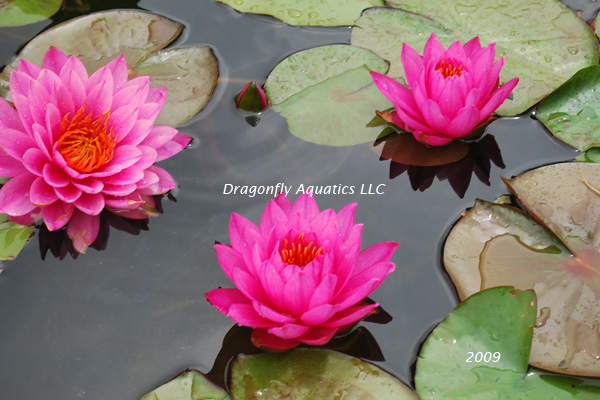 As the weather warms up and we begin to assess what plants we want to add to our ponds this spring, make sure you check out your hardy water lilies to see if they are in need of re-potting. Adding Highland Rim Fertilizer tablets at this time is also a must do. Water lilies need to be fertilized every 4-6 weeks to ensure plenty of flowers this summer.
As the weather warms up and we begin to assess what plants we want to add to our ponds this spring, make sure you check out your hardy water lilies to see if they are in need of re-potting. Adding Highland Rim Fertilizer tablets at this time is also a must do. Water lilies need to be fertilized every 4-6 weeks to ensure plenty of flowers this summer.
Dividing the water lilies and re-potting them in early spring will ensure a better performing water lily this summer. Several lilies in the same pot compete for available nutrients resulting in fewer flowers this summer.
Water lilies need to be planted in at least a 1 gallon planting container for best performance. The medium to large varieties should be potted in a 2 to 5 gallon planting container to reach maximum flowering and growing potential. Don't be fooled by purchasing a potted lily in a 4 inch pot and expect it to flourish in your pond. You will end up paying more for the lily, and will still need to purchase a larger container to re-pot the lily in.
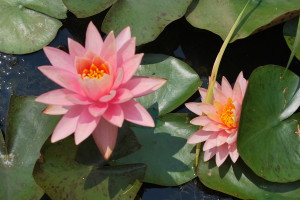 With the lower temperatures during the fall season, you will notice a decrease in water lily blooms and the lily pads turning yellow as the water temperatures cool. It is important at this time to remove the dead leaves and spent blooms to avoid having the debris in the pond over winter. As winter approaches and water temperatures drop, the water lily will go dormant. Remove all dead lily pads and lower the potted lily to the deepest part of the pond or to a water depth of about two feet.
With the lower temperatures during the fall season, you will notice a decrease in water lily blooms and the lily pads turning yellow as the water temperatures cool. It is important at this time to remove the dead leaves and spent blooms to avoid having the debris in the pond over winter. As winter approaches and water temperatures drop, the water lily will go dormant. Remove all dead lily pads and lower the potted lily to the deepest part of the pond or to a water depth of about two feet.
Hardy Water Lilies,Pink Grapefruit at Dragonfly Aquatics.
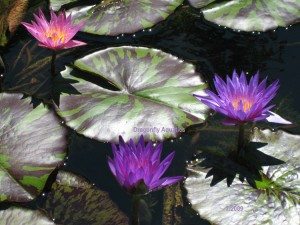 The weather has been pretty hot lately. The tropical lilies are blooming like crazy. If you've been having hot weather lately you may want to keep adding some fresh cold water to your ponds. This replenishes the water loss through evaporation and also gives your fish some fresh water.
The weather has been pretty hot lately. The tropical lilies are blooming like crazy. If you've been having hot weather lately you may want to keep adding some fresh cold water to your ponds. This replenishes the water loss through evaporation and also gives your fish some fresh water.
We all look forward to the summer when we can start enjoying the fruits of our labor. If your like me, when the flowers start blooming and our ponds get the coverage they need to help prevent the algae growth, we sit back and think about what we can add next or change next. I often sit next to my pond and think should I just sit here and enjoy the peace or go and start picking the greens and tomatoes from the garden....tough decision. I decided to work in the garden. Since I'm always trying to find recipes to use the abundant crop of zucchini I get, I thought I'd share this delicious recipe I just received from a friend. I know its not pond related but who doesn't enjoy eating.
Chocolate Zucchini Cake
Combine and set aside the following: 2 cup unsifted flour, 1/4 cup unsweetened dark cocoa, 1 tsp. baking powder, 1 tsp. baking soda, 1 tsp. ground cinnamon and 1/4 tsp. salt.
In mixing bowl at high speed beat together, 3 large eggs, 1 1/2 cup granulated sugar. Beat this until light and fluffy then at low speed gradually add the following: 1/2 cup cooking oil until well blended and then the above flour mixture. Blend in 1/2 cup sour cream and then add 1 1/2 cup zucchini into mixture. (You can pat this in paper towels to remove any extra moisture before adding into mixture.)
To add alittle extra try cream cheese and peanut butter for the icing or use your own recipe for icing.
Bake at 350 degrees for 30-35 minutes in a 9x13 greased and floured pan.
YUMMY! Now you can cut yourself a piece and sit by your pond and enjoy both the cake and your pond!
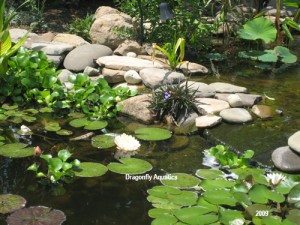 As any gardener knows, after the planting is finished there is always work to be done in the garden. I recently had some little white bugs on my Spider Lily and thought I would share my remedy for this.
As any gardener knows, after the planting is finished there is always work to be done in the garden. I recently had some little white bugs on my Spider Lily and thought I would share my remedy for this.
There are alot of products on the market for killing aphids that sometimes find our plants in the water garden. I use a mixture of soap and water to spray mine which seems to work for me rather than purchasing a product on the market. This is natural and won't harm your plants, fish or water.
1 Tbl liquid dish soap and 1 cup oil. Mix this together and then take 1 tsp of this mixture and add it to 1 qt of water and put it into a spray bottle. You don't want to do this during the hot sunny day but during the evening or early morning when its cooler. Its never a good idea to treat any plant during the heat of the day.
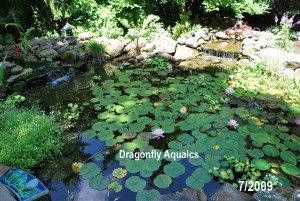 There are some essential tasks to take care of during the summer while enjoying your pond. Water plants can outgrow their containers during the warm summer months. If your waterlilies are covering too much pond surface, simply prune outer leaves of the lily down to half their spread. You will want to remove dead lily pads and spent flowers. These not only create an unsightly appearance but decaying matter will create other problems in your pond.
There are some essential tasks to take care of during the summer while enjoying your pond. Water plants can outgrow their containers during the warm summer months. If your waterlilies are covering too much pond surface, simply prune outer leaves of the lily down to half their spread. You will want to remove dead lily pads and spent flowers. These not only create an unsightly appearance but decaying matter will create other problems in your pond.
If your submerged plants have grown to the surface of the pond, you will want to cut them back so the plants are 6 to 10 inches below the water surface. Anacharis and hornwort can be netted out, cutting back from the bottom of the plant as the top of the plant is the growing portion. Attach a new lead weight and simply toss them back into the pond or repot in pots of pea gravel.
Marginal plants, bog plants and floating plants can all be trimmed of old, brown growth. Don't be afraid to trim back or discard part of any plant that might be taking over your pond. You need to have an area of pond surface open to sunlight for oxygen exchange.
Water plants will grow quickly during the warm weather. Fertilize them with Highland Rim Aquatic Fertilizer Tablets every few weeks, instead of monthly, to encourage them to grow and bloom, putting on a fantastic show.
If some of your water plants require more than a trim, there is still time before fall to divide them. Fall is too late to divide some plants, especially if you live in a cooler climate. They need time and warmth to grow a new root system, before going dormant for the winter.
Now, I'm going out to practice what I preach! As you can see from the photo, I have a few hours of work to do! My lilies and submerged plants are covering most of the surface area in my pond. I will post a new picture, once I have things back under control.
There are five different types of plants that you will want to add to your pond to provide beauty and help you achieve an ecological balance in your water garden.
Submerged plants such as Anacharis, Vallisneria, Cabomba, Hornwort and Red Ludwigia remove nutrients from the water so algae can’t thrive. Submerged plants do not need soil. Just plant them in one-gallon pots or plant baskets filled with pea gravel and place them in the bottom of your pond. Or purchase plant anchors with your plant order, and simply wrap the weights around the bunch of plants and they will sink to the bottom of the pond.
Water Hyacinth, Water Lettuce, Frog Bit, Parrot’s Feather and Azolla are all members of the floating plant family. Floating plants are very useful in keeping the pond water clean and clear. These are simple plants that free-float and do not need to be potted. You simply toss them into the water garden where they are extremely beneficial to the pond. Floating plants shade the surface and with their roots dangling in the water they pull nutrients from the water essentially starving the algae. They tend to be quite prolific and provide hiding places for baby fish and other water garden inhabitants.
Otherwise known as water lilies, they grow in pots placed 12 to 36 inches deep and have foliage and flowers that bloom on top of the water’s surface. Water lilies provide shade for the fish and add coverage to the water’s surface. Water lilies are available in many different colors and sizes.
Lotus are also considered a hardy water plant that can also be planted deep in your pond and its flowers and leaves will help provide shade and coverage.
Plants such as the hardy canna (Thalia dealbata) grow in mud or 8 to 12 inches deep in the water. Arrange them on platform shelves on the edge of your pond to conceal the water garden’s artificial edges. Plant bog and marginal plants in plastic pots, then place the pot under the water and let the plants grow in the open air. When the plants are young, use care and gradually lower them deeper as the plant matures.
Bog Plants and Marginal Plants
Marginal and bog plants grow in damp soil just outside a pond. They are good transition plants between land and water. Some tolerate completely waterlogged ground and others will not tolerate more than moist soil, check each plant’s requirements carefully.
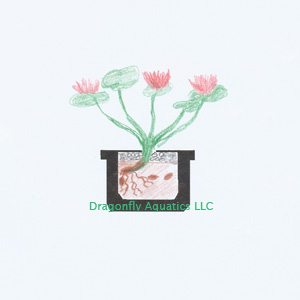 When you plant a hardy water lily you want to first place the tuber at a 45 degree angle with the non-growing end against the side of the pot. Add aquatic fertilizer tablets right in front of the crown (growing end) of the tuber. Hardy lilies are heavy feeders and should be fertilized about every 3-4 weeks during their growing season. Be careful that the fertilizer is not touching the crown of the plant. Add a layer of gravel over the soil, again being careful not to cover the crown of the lily. It is better to plant lilies too high, than to plant them too deep. We like to use gravel that is at least 1/2" in diameter. The gravel keeps the fish from digging into the aquatic planting media (clay dirt). If you use gravel this size it will prevent your fish from trying to eat it. Hardy lilies should be placed on the bottom of your pond or on a shelf at 18" to 30" deep.
When you plant a hardy water lily you want to first place the tuber at a 45 degree angle with the non-growing end against the side of the pot. Add aquatic fertilizer tablets right in front of the crown (growing end) of the tuber. Hardy lilies are heavy feeders and should be fertilized about every 3-4 weeks during their growing season. Be careful that the fertilizer is not touching the crown of the plant. Add a layer of gravel over the soil, again being careful not to cover the crown of the lily. It is better to plant lilies too high, than to plant them too deep. We like to use gravel that is at least 1/2" in diameter. The gravel keeps the fish from digging into the aquatic planting media (clay dirt). If you use gravel this size it will prevent your fish from trying to eat it. Hardy lilies should be placed on the bottom of your pond or on a shelf at 18" to 30" deep.
Click on picture to enlarge.
Here it is Spring....the task begins for us water gardeners. Clean the pond, check the water, make sure pumps are working properly, tell the fish "I know you think your hungry, but I cannot feed you until the water temperatures get a little higher..." and then the task of dividing those water lilies to start new ones. It's a lot easier just to purchase new ones, those I don't have, but want.
Dividing and re-potting lilies is not a hard task, but a messy one. It is essential for their health and vitality. When a water lily grows it will eventually grow over and out of its pot. It fills the container with roots and rhizomes, displacing the soil and leaving no room to fertilize it. You can divide it and discard the old roots and rhizomes making space for the lily to renew its strength and keep flowering well.
You will know when it is time to divide a lily when it stops blooming as well and its foliage starts crowding. The leaves become smaller and more sparse. The best time to divide lilies is in the early spring, just before the lily starts to actively grow.
Take the lily out of the pot. Remove the soil by using a spray of water from a garden hose to completely wash away the soil from the rhizome. Generally, a rhizome has a main growing tip. Next select the part or parts from the rhizome that are the nicest. Cut to about three or four inches long and discard any remaining part of the rhizome left. Trim away excess roots and damaged foliage. If you aren't going to re-pot at this time keep the new plant in the shade with damp newspaper covering the plant or submerged in shallow water.
Fill your container with a clay base soil, mound against one side of the container and place the rhizome at a 45 degree angle with the cut edge against the pot and the growing point at the level of where the top of the soil will be. At this point you would want to add a couple fertilizer tablets, one on each side of the plant. You can then add more soil to within a couple of inches from the top of the container. Press the soil firmly in place and add about one inch of small pea gravel to cover the soil but keep it off the growing point of the plant. You can then gently add some water to the container and slowly lower the plant into the pond. If you place it just a few inches under the water for the first few weeks, you will get new growth faster. Then you can place the plant at your proper growing depth which is normally 12 - 20 inches of water over the top of the plant.
Continue to feed your newly planted water lily one fertilizer tablet per gallon of soil monthly and the result will be another great performing lily.